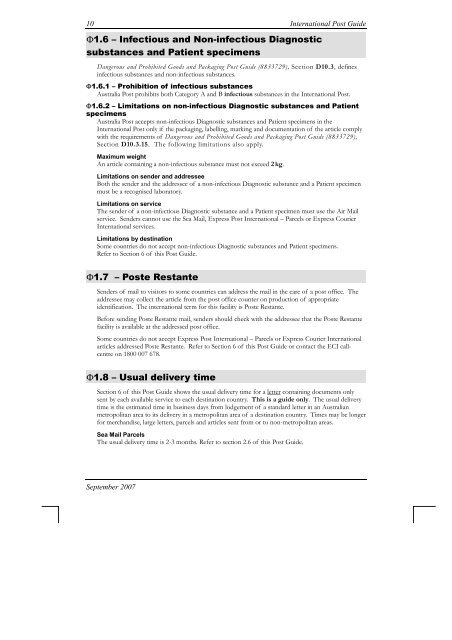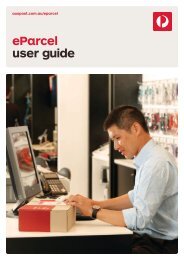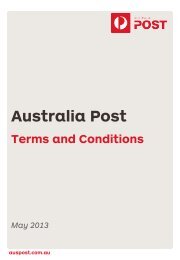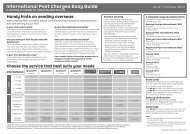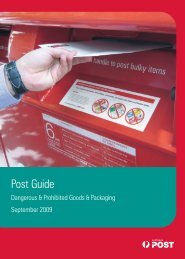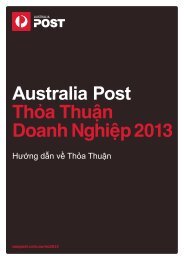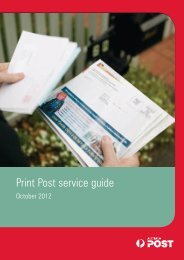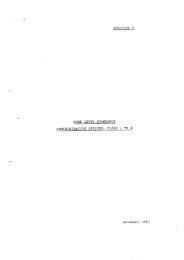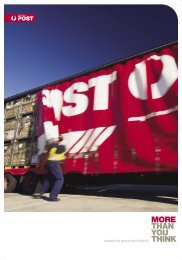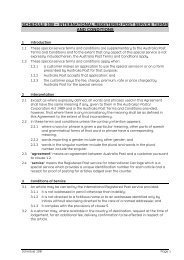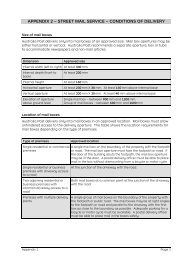- Page 1 and 2: International Post Regulations Cust
- Page 3 and 4: 2 International Post Guide Addressi
- Page 5 and 6: 4 International Post Guide How to u
- Page 7 and 8: 6 International Post Guide SECTION
- Page 9: 8 International Post Guide �1.1.4
- Page 13 and 14: 12 International Post Guide �2.1.
- Page 15 and 16: 14 International Post Guide �2.2
- Page 17 and 18: 16 International Post Guide �2.3
- Page 19 and 20: 18 International Post Guide �2.3.
- Page 21 and 22: 20 International Post Guide �2.5
- Page 23 and 24: 22 International Post Guide �2.7
- Page 25 and 26: 24 International Post Guide �2.8
- Page 27 and 28: 26 International Post Guide Layout
- Page 29 and 30: 28 International Post Guide �2.11
- Page 31 and 32: 30 International Post Guide �3.1.
- Page 33 and 34: 32 International Post Guide �4.2
- Page 35 and 36: 34 International Post Guide �5.4
- Page 37 and 38: 36 International Post Guide �5.4.
- Page 39 and 40: 38 International Post Guide �5.8
- Page 41 and 42: 40 International Post Guide �5.9.
- Page 43 and 44: 42 International Post Guide �5.13
- Page 45 and 46: 44 International Post Guide �5.15
- Page 47 and 48: 46 International Post Guide �5.16
- Page 49 and 50: 48 International Post Guide Valuabl
- Page 51 and 52: A 50 International Post Guide Septe
- Page 53 and 54: A 52 International Post Guide Septe
- Page 55 and 56: A 54 International Post Guide Septe
- Page 57 and 58: A 56 International Post Guide Septe
- Page 59 and 60: A 58 International Post Guide Septe
- Page 61 and 62:
A 60 International Post Guide Septe
- Page 63 and 64:
B 62 International Post Guide Septe
- Page 65 and 66:
B 64 International Post Guide Septe
- Page 67 and 68:
B 66 International Post Guide Septe
- Page 69 and 70:
B 68 International Post Guide Inclu
- Page 71 and 72:
B 70 International Post Guide Septe
- Page 73 and 74:
B 72 International Post Guide Septe
- Page 75 and 76:
B 74 International Post Guide Septe
- Page 77 and 78:
B 76 International Post Guide Septe
- Page 79 and 80:
B 78 International Post Guide Septe
- Page 81 and 82:
B 80 International Post Guide Septe
- Page 83 and 84:
C 82 International Post Guide Septe
- Page 85 and 86:
C 84 International Post Guide Septe
- Page 87 and 88:
C 86 International Post Guide Septe
- Page 89 and 90:
C 88 International Post Guide Septe
- Page 91 and 92:
90 International Post Guide CHINA -
- Page 93 and 94:
C 92 International Post Guide Septe
- Page 95 and 96:
C 94 International Post Guide Septe
- Page 97 and 98:
C 96 International Post Guide Septe
- Page 99 and 100:
C 98 International Post Guide Ivory
- Page 101 and 102:
C 100 International Post Guide CROA
- Page 103 and 104:
C 102 International Post Guide Sept
- Page 105 and 106:
D 104 International Post Guide Sept
- Page 107 and 108:
D 106 International Post Guide Sept
- Page 109 and 110:
E 108 International Post Guide Sept
- Page 111 and 112:
E 110 International Post Guide Sept
- Page 113 and 114:
E 112 International Post Guide Sept
- Page 115 and 116:
E 114 International Post Guide Sept
- Page 117 and 118:
F 116 International Post Guide Sept
- Page 119 and 120:
F 118 International Post Guide Sept
- Page 121 and 122:
F 120 International Post Guide FRAN
- Page 123 and 124:
F 122 International Post Guide Sept
- Page 125 and 126:
G 124 International Post Guide Sept
- Page 127 and 128:
G 126 International Post Guide Sept
- Page 129 and 130:
G 128 International Post Guide Sept
- Page 131 and 132:
G 130 International Post Guide Sept
- Page 133 and 134:
G 132 International Post Guide Sept
- Page 135 and 136:
G 134 International Post Guide Sept
- Page 137 and 138:
G 136 International Post Guide Sept
- Page 139 and 140:
H 138 International Post Guide Sept
- Page 141 and 142:
H 140 International Post Guide Sept
- Page 143 and 144:
H 142 International Post Guide HUNG
- Page 145 and 146:
I 144 International Post Guide Sept
- Page 147 and 148:
I 146 International Post Guide Sept
- Page 149 and 150:
I 148 International Post Guide Sept
- Page 151 and 152:
I 150 International Post Guide Sept
- Page 153 and 154:
J 152 International Post Guide Sept
- Page 155 and 156:
J 154 International Post Guide Sept
- Page 157 and 158:
K 156 International Post Guide KAZA
- Page 159 and 160:
K 158 International Post Guide Sept
- Page 161 and 162:
K 160 International Post Guide Sout
- Page 163 and 164:
K 162 International Post Guide Sept
- Page 165 and 166:
L 164 International Post Guide Sept
- Page 167 and 168:
L 166 International Post Guide Sept
- Page 169 and 170:
L 168 International Post Guide Incl
- Page 171 and 172:
L 170 International Post Guide Sept
- Page 173 and 174:
M 172 International Post Guide Sept
- Page 175 and 176:
M 174 International Post Guide MACE
- Page 177 and 178:
M 176 International Post Guide Sept
- Page 179 and 180:
M 178 International Post Guide Sept
- Page 181 and 182:
M 180 International Post Guide Sept
- Page 183 and 184:
M 182 International Post Guide Sept
- Page 185 and 186:
M 184 International Post Guide Sept
- Page 187 and 188:
M 186 International Post Guide Sept
- Page 189 and 190:
M 188 International Post Guide Form
- Page 191 and 192:
M 190 International Post Guide For
- Page 193 and 194:
M 192 International Post Guide Sept
- Page 195 and 196:
M 194 International Post Guide Form
- Page 197 and 198:
N 196 International Post Guide Sept
- Page 199 and 200:
N 198 International Post Guide Holl
- Page 201 and 202:
N 200 International Post Guide Incl
- Page 203 and 204:
N 202 International Post Guide Sept
- Page 205 and 206:
N 204 International Post Guide Sept
- Page 207 and 208:
N 206 International Post Guide Sept
- Page 209 and 210:
P 208 International Post Guide Sept
- Page 211 and 212:
P 210 International Post Guide Incl
- Page 213 and 214:
P 212 International Post Guide Sept
- Page 215 and 216:
P 214 International Post Guide Sept
- Page 217 and 218:
P 216 International Post Guide Sept
- Page 219 and 220:
P 218 International Post Guide Sept
- Page 221 and 222:
R 220 International Post Guide Sept
- Page 223 and 224:
R 222 International Post Guide ROMA
- Page 225 and 226:
R 224 International Post Guide Russ
- Page 227 and 228:
S 226 International Post Guide Sept
- Page 229 and 230:
S 228 International Post Guide Sept
- Page 231 and 232:
S 230 International Post Guide Sept
- Page 233 and 234:
S 232 International Post Guide Sept
- Page 235 and 236:
S 234 International Post Guide Sept
- Page 237 and 238:
S 236 International Post Guide Serb
- Page 239 and 240:
S 238 International Post Guide Sept
- Page 241 and 242:
S 240 International Post Guide Sept
- Page 243 and 244:
S 242 International Post Guide Sept
- Page 245 and 246:
S 244 International Post Guide SLOV
- Page 247 and 248:
S 246 International Post Guide Sept
- Page 249 and 250:
S 248 International Post Guide Incl
- Page 251 and 252:
S 250 International Post Guide Sept
- Page 253 and 254:
S 252 International Post Guide Sept
- Page 255 and 256:
S 254 International Post Guide Sept
- Page 257 and 258:
T 256 International Post Guide Sept
- Page 259 and 260:
T 258 International Post Guide Incl
- Page 261 and 262:
T 260 International Post Guide Sept
- Page 263 and 264:
T 262 International Post Guide Frie
- Page 265 and 266:
T 264 International Post Guide Sept
- Page 267 and 268:
T 266 International Post Guide Sept
- Page 269 and 270:
T 268 International Post Guide Sept
- Page 271 and 272:
T 270 International Post Guide Sept
- Page 273 and 274:
U 272 International Post Guide Sept
- Page 275 and 276:
U 274 International Post Guide Sept
- Page 277 and 278:
U 276 International Post Guide UNIT
- Page 279 and 280:
U 278 International Post Guide UNIT
- Page 281 and 282:
U 280 International Post Guide Sept
- Page 283 and 284:
V 282 International Post Guide Sept
- Page 285 and 286:
V 284 International Post Guide Sept
- Page 287 and 288:
V 286 International Post Guide Sept
- Page 289 and 290:
Y 288 International Post September
- Page 291 and 292:
Z 290 International Post Guide Sept
- Page 293 and 294:
292 Destination cross-reference ind
- Page 295 and 296:
294 Destination cross-reference ind
- Page 297 and 298:
296 Destination cross-reference ind
- Page 299 and 300:
298 Destination cross-reference ind
- Page 301 and 302:
300 International Post Guide E EDN
- Page 303 and 304:
302 International Post Guide Septem


